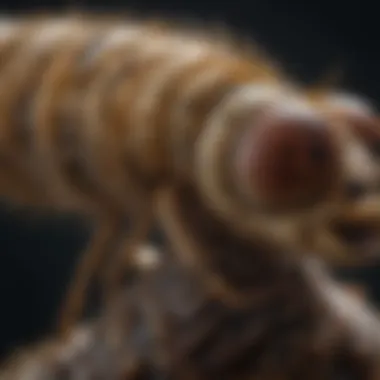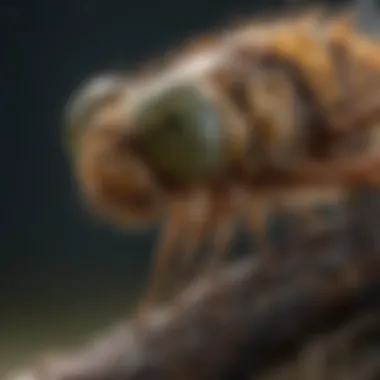Unveiling the Enigmatic World of Dragonfly Larvae: An In-Depth Exploration


The Diverse World of Dragonfly Larvae: An In-Depth Exploration
Within the intricate realm of freshwater ecosystems resides a fascinating and often overlooked creature: the dragonfly larvae. These enigmatic beings, with their alien-like appearance and predatory instincts, play a crucial role in maintaining the delicate balance of aquatic environments. Their unique characteristics, intricate lifecycle, behavioral patterns, and ecological significance are all elements that elevate dragonfly larvae to a position of interest and importance within the natural world.
Unveiling Mysteries: The Characteristics of Dragonfly Larvae
Dragonfly larvae, also known as nymphs, exhibit a diversity of forms and adaptations that set them apart from their adult counterparts. Their elongated bodies, often equipped with specialized appendages for propulsion, are designed for efficient movement through water. The presence of gills along their abdomen enables them to extract oxygen from the aquatic environment, showcasing a finely tuned respiratory system evolved for survival in freshwater habitats. Positioned at the juncture between water and air, dragonfly larvae embody a curious mix of terrestrial and aquatic traits that define their existence.
In addition to their physical attributes, dragonfly larvae possess formidable hunting prowess, utilizing their extendable mouthparts for capturing prey with precision and agility. Their relentless predatory behavior not only aids in their own sustenance but also serves as a crucial force in controlling insect populations within their ecosystem. Moreover, the ability of certain species to camouflage themselves within their surroundings showcases an evolutionary strategy honed over millennia to avoid predators and secure their place in the ecological web.
The Enigmatic Lifecycle of Dragonfly Larvae
The lifecycle of a dragonfly begins with the hatching of an egg laid beneath the surface of the water by an adult dragonfly. Upon emerging, the larva embarks on a journey of growth and transformation, shedding its skin multiple times in a process known as molting. Each stage of development, marked by a new instar, brings the nymph closer to adulthood, culminating in a final molt where it emerges as a fully formed dragonfly, ready to take flight.
This metamorphosis from water-dwelling larva to aerial acrobat is a testament to the resilience and adaptability of these creatures. The transition from a life spent in the depths of ponds and streams to one of flight and movement signifies a profound change, mirrored in the behavioral shifts and physiological adaptations that accompany this transformation. It is a saga of survival and growth, intricately interwoven with the rhythms of nature and the imperatives of evolution.
Steadfast Guardians: The Ecological Significance of Dragonfly Larvae
In the intricate tapestry of aquatic ecosystems, dragonfly larvae emerge as steadfast guardians, wielding their predatory prowess to maintain the delicate balance of life within their habitats. By preying on a variety of aquatic organisms, ranging from mosquito larvae to small fish, dragonfly nymphs act as natural regulators, preventing population explosions and preserving the equilibrium of their environment. This role as biological control agents underscores the ecological significance of dragonfly larvae, highlighting their contribution to the health and stability of freshwater ecosystems.
Beyond their role as predators, dragonfly larvae also serve as indicators of water quality, with their presence or absence reflecting the environmental conditions of their habitat. Sensitive to pollution and fluctuations in temperature, these aquatic sentinels provide valuable insights into the overall health of freshwater systems. By monitoring the abundance and diversity of dragonfly larvae, researchers and conservationists can glean important data on water quality, biodiversity, and ecosystem integrity, guiding efforts to protect and sustain these vital natural resources.
Synthesizing Knowledge: The Intriguing World of Dragonfly Larvae
From their enigmatic characteristics to their pivotal ecological roles, dragonfly larvae offer a window into the intricate web of life that sustains our planet. Their adaptability, resilience, and multifaceted interactions within aquatic ecosystems embody the complexity and beauty of the natural world, inviting us to ponder the mysteries of evolution and the interconnectedness of all living beings. By unraveling the secrets of dragonfly larvae, we not only enhance our understanding of these fascinating creatures but also gain insights into the broader mechanisms that govern life on Earth.
As we delve deeper into the nuances of dragonfly larvae, we are confronted with a tapestry of marvels and challenges, each revealing a new layer of complexity and awe. Their story, woven into the fabric of ecosystems worldwide, serves as a reminder of the intricate dynamics that shape our planet and the extraordinary beings that inhabit its diverse landscapes. By exploring the hidden world of dragonfly larvae, we embark on a journey of discovery and enlightenment, where each revelation sparks a deeper appreciation for the wonders of the natural world.


Introduction
In the intricate tapestry of nature's creations, there exists a world of marvel concealed beneath the shimmering surface of water bodies - the realm of dragonfly larvae. These enigmatic beings, often overshadowed by their adult counterparts, hold a wealth of secrets waiting to be unraveled. This article embarks on a journey to illuminate the hidden complexities and marvels of dragonfly larvae, delving deep into their unique characteristics, behavior, lifecycle, and ecological importance. Our exploration will transcend mere observation, offering a profound insight into the intricate web of life these fascinating creatures inhabit.
The importance of comprehending the world of dragonfly larvae transcends a mere glance at their physical form. While their adult forms grace the skies with elegance, it is in their larval stage that we unearth a treasure trove of adaptations honed through millions of years of evolution. Understanding these larvae is not merely an academic pursuit but a gateway to comprehending the subtle yet crucial interactions that sustain our delicate ecosystems. By dissecting the mysteries surrounding dragonfly larvae, we peer into the intricate mechanisms at play within the natural world, shedding light on the often-overlooked intricacies of aquatic life. Delving into this captivating subject promises to enrich our understanding of nature's craftsmanship and unveil the hidden connections that underpin the ecosystem's delicate balance.
Introduction
The world of dragonfly larvae is a realm of intrigue, a domain where nature's wonders unfold in fascinating ways. In this comprehensive guide, we will embark on a journey to explore the captivating realm of dragonfly larvae, uncovering their unique characteristics, behavior, and ecological significance. From their remarkable hunting prowess to their crucial role in aquatic ecosystems, these creatures hold the key to understanding a dynamic and vibrant world.
Overview of Dragonfly Larvae
What are Dragonfly Larvae?
Dragonfly larvae, also known as nymphs, are the early life stage of dragonflies, existing in aquatic environments. These larvae play a crucial role in the life cycle of dragonflies, undergoing significant transformations before emerging as adults.
Physical Characteristics
Dragonfly larvae display a fascinating array of physical characteristics that set them apart in the animal kingdom. Their elongated bodies, segmented into distinct sections, culminate in an impressive set of six legs and three caudal appendages. These features facilitate their adept movement and predatory activities in the water.
Habitat and Distribution
Dragonfly larvae predominantly inhabit freshwater bodies such as ponds, lakes, and streams. Their distribution spans across various geographical regions globally, showcasing adaptability to diverse aquatic habitats. These larvae are integral components of freshwater ecosystems, contributing to the balance and biodiversity of their surroundings.
Lifecycle of Dragonfly Larvae
Dragonfly larvae undergo a fascinating lifecycle that plays a crucial role in the ecosystem. The development of dragonfly larvae from eggs to nymphs and finally to adulthood is a complex process filled with remarkable adaptations and behaviors. Understanding the lifecycle of dragonfly larvae is vital to grasp their significance in the natural world. Throughout this section, we will delve deep into each stage, highlighting key points and shedding light on their relevance to the broader ecosystem.


Egg Stage
The egg stage marks the beginning of a dragonfly larva's life cycle. Female dragonflies carefully deposit their eggs in or near water bodies, ensuring a suitable habitat for their offspring. These eggs are often laid in clusters or individually, depending on the species. The duration of the egg stage varies among different dragonfly species, with some requiring just a few weeks to hatch, while others may remain dormant through winter months. This stage is critical for the survival and propagation of dragonflies, setting the foundation for the emergence of the next generation.
Nymph Stage
As dragonfly eggs hatch, they give rise to nymphs, also known as larvae. Nymphs are remarkable creatures adapted for an aquatic lifestyle. Equipped with specialized mouthparts for capturing prey and unique respiratory systems to extract oxygen from water, nymphs thrive underwater as efficient predators. The nymph stage is characterized by multiple molts, where larvae outgrow their exoskeleton and develop stronger body structures. This stage is vital for nymphs to prepare for their eventual emergence as adult dragonflies, undergoing significant physiological changes that culminate in their transformation.
Adult Emergence
The final stage of the dragonfly larva's lifecycle is adult emergence, where nymphs transition into winged adults. Upon completing their development underwater, nymphs climb onto emergent vegetation or rocks before emerging from their exoskeletons as adult dragonflies. The process of metamorphosis from aquatic dwellers to aerial acrobats is a marvel of nature, showcasing the adaptability and resilience of dragonfly larvae. Adult dragonflies play essential roles in pollination, pest control, and as indicators of ecosystem health, making their successful emergence crucial for maintaining ecological balance.
Adaptations and Behavior
Dragonfly larvae adaptations and behavior play a pivotal role in their survival and ecological impact. These intricate mechanisms are finely tuned to support their hunting strategies and overall development. The adaptations of dragonfly larvae include specialized body structures that aid in efficient movement and prey capture. Their behavior is primarily focused on efficient hunting methods, characterized by swift movements and precise targeting of prey items. These adaptations and behaviors are crucial for their successful progression through the nymph stage and eventual emergence as adult dragonflies.
Feeding Habits
The feeding habits of dragonfly larvae are crucial aspects of their adaptation and survival. These voracious predators have a diet primarily consisting of other aquatic organisms, including insects, small fish, and even tadpoles. Their feeding habits are essential for maintaining a balanced aquatic ecosystem by controlling the population of their prey species. Dragonfly larvae exhibit a fascinating mechanism of capturing prey using their specialized mouthparts and agile movements, showcasing their efficient feeding strategies in their aquatic environment.
Predatory Strategies
Dragonfly larvae employ diverse predatory strategies to secure their food source and thrive in their aquatic habitats. These strategies range from ambush predation to active hunting techniques, allowing them to adapt to different prey types and environmental conditions. Their predatory behaviors are honed through instinct and experience, resulting in highly successful hunting endeavors. By preying on various organisms within their ecosystem, dragonfly larvae contribute to the ecological balance and play a crucial role in the food chain dynamics of their aquatic environment.
Larval Development
The development of dragonfly larvae from the egg stage to adulthood is a complex and fascinating process driven by various environmental factors and biological adaptations. Larval development is marked by distinct growth stages, each characterized by specific physiological and behavioral changes. As dragonfly larvae progress through their nymph stage, they undergo molting processes, shedding their exoskeleton to accommodate growth. This developmental journey is essential for their overall growth and maturation, paving the way for their emergence as adult dragonflies ready for reproduction and continuation of their species' lifecycle.


Ecological Importance
Dragonfly larvae play a crucial role in maintaining the balance of aquatic ecosystems. These larvae are voracious predators, feeding on a variety of aquatic organisms like mosquito larvae and small fish. By controlling the population of these organisms, dragonfly larvae help in preventing outbreaks of disease-carrying insects and maintaining the overall health of water bodies. Their presence serves as a natural pest control mechanism, reducing the need for harmful chemical interventions in controlling insect populations. Moreover, dragonfly larvae act as indicators of water quality, as they are sensitive to pollution and habitat degradation. Monitoring dragonfly larvae populations can provide valuable insights into the environmental conditions of aquatic ecosystems. Understanding their ecological importance can aid in conservation efforts and ecosystem management practices.
Role in Aquatic Ecosystems
Dragonfly larvae are apex predators in freshwater environments, preying on a wide range of prey species. Their voracious appetite for mosquito larvae, small fish, and other aquatic insects helps in regulating population levels and maintaining the biodiversity of aquatic habitats. This predation pressure cascades through the food web, influencing the abundance and distribution of other species within the ecosystem. Dragonfly larvae, with their efficient hunting strategies and agile movements, contribute significantly to the overall ecological balance of aquatic ecosystems.
Environmental Indicators
The presence and abundance of dragonfly larvae can serve as reliable indicators of environmental health in aquatic ecosystems. These sensitive creatures are affected by changes in water quality, pollution levels, and habitat disturbances. A decline in dragonfly larvae populations may signal deteriorating environmental conditions, such as pollution or habitat destruction. Monitoring the population dynamics of dragonfly larvae can offer early warnings of ecosystem stress and guide conservation efforts to mitigate environmental impacts. By understanding their role as environmental indicators, researchers and conservationists can use dragonfly larvae as tools for assessing ecosystem health.
Interactions with Other Species
Dragonfly larvae interact with a wide array of species within aquatic ecosystems, influencing food web dynamics and community structure. As top predators, they regulate the populations of their prey, shaping the abundance and distribution of various organisms within the ecosystem. Additionally, dragonfly larvae serve as prey for larger predators, contributing to the transfer of energy through trophic levels. Their interactions with other species highlight the interconnectedness of aquatic communities and underscore the importance of conserving these keystone predators for the stability and resilience of freshwater ecosystems.
Research and Conservation
Studies on Dragonfly Larvae
The rigorous Studies on Dragonfly Larvae form the bedrock of our knowledge regarding these enigmatic creatures. Researchers employ various techniques, ranging from field observations to laboratory experiments, to uncover the hidden secrets of dragonfly larvae. Through detailed studies, scientists have unearthed essential information about their feeding habits, growth patterns, and the factors influencing their survival. These studies not only contribute to scientific literature but also pave the way for informed conservation strategies and management practices aimed at protecting dragonfly larvae and their habitats.
Challenges and Threats
Despite their resilience, dragonfly larvae face a myriad of Challenges and Threats in their quest for survival. Pollution, habitat destruction, climate change, and invasive species pose significant risks to their populations. These threats can disrupt their delicate ecological balance, leading to potential declines in their numbers and overall biodiversity loss. Understanding and addressing these challenges are paramount to ensuring the long-term viability of dragonfly larvae and the ecosystems they inhabit.
Conservation Efforts
Efforts aimed at Conservation play a pivotal role in safeguarding the future of dragonfly larvae. Conservation initiatives encompass habitat restoration, pollution mitigation, and public awareness campaigns to garner support for these charismatic insects. By promoting responsible land management practices and advocating for the protection of freshwater habitats, conservationists strive to create a conducive environment for dragonfly larvae to thrive. Collaborative efforts between researchers, policymakers, and the community are essential to securing a sustainable future for these captivating creatures.
Conclusion
Dragonfly larvae, with their intricate characteristics and vital ecological role, embody a fascinating subject worthy of exploration and study. Throughout this comprehensive guide on the world of dragonfly larvae, several key points have emerged that shed light on the significance of understanding these remarkable creatures.## Importance of Dragonfly Larvae Research Research on dragonfly larvae plays a pivotal role in unraveling the mysteries of aquatic ecosystems and biodiversity. By studying the feeding habits, predatory strategies, and larval development of dragonfly larvae, researchers gain valuable insights into the delicate balance of natural systems. Their adaptability and responses to environmental changes provide crucial data for ecological conservation and management purposes. Through research efforts, we can enhance our understanding of these intricate creatures and contribute to the preservation of fragile ecosystems.## Conservation Implications The challenges and threats facing dragonfly larvae underscore the urgent need for conservation efforts. Habitat destruction, pollution, and climate change pose significant risks to the survival of these species. Conservation initiatives aimed at safeguarding dragonfly larvae involve habitat restoration, pollution control, and public awareness campaigns. By protecting the habitats of dragonfly larvae, we not only ensure the survival of these iconic creatures but also safeguard the overall health of aquatic ecosystems. Conservation efforts play a vital role in maintaining biodiversity and ecological balance, making them indispensable for the long-term sustainability of our planet.## Concluding Remarks







